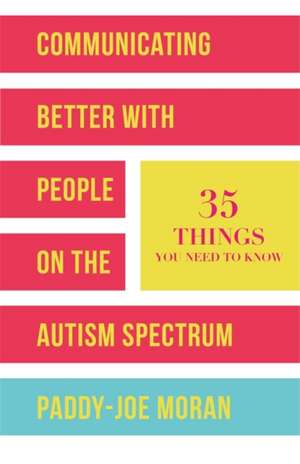Communicating Better with People on the Autism Spectrum
Autor Paddy-Joe Moranen Limba Engleză Paperback – 17 aug 2016
Preț: 65.00 lei
Preț vechi: 79.94 lei
-19% Nou
Puncte Express: 98
Preț estimativ în valută:
12.44€ • 12.99$ • 10.27£
12.44€ • 12.99$ • 10.27£
Indisponibil temporar
Doresc să fiu notificat când acest titlu va fi disponibil:
Se trimite...
Preluare comenzi: 021 569.72.76
Specificații
ISBN-13: 9781849057080
ISBN-10: 1849057087
Pagini: 104
Dimensiuni: 173 x 201 x 8 mm
Greutate: 0.07 kg
Editura: JESSICA KINGSLEY PUBLISHERS
ISBN-10: 1849057087
Pagini: 104
Dimensiuni: 173 x 201 x 8 mm
Greutate: 0.07 kg
Editura: JESSICA KINGSLEY PUBLISHERS
Notă biografică
Paddy-Joe Moran was diagnosed with autism when he was eight. He is a writer and blogger and runs the online advice service Ask-Pergers?. Paddy-Joe co-authored Helping Children with Autism Spectrum Conditions through Everyday Transitions and Create a Reward Plan for your Child with Asperger Syndrome, both published by Jessica Kingsley Publishers. He is based in Manchester, UK.
Cuprins
Introduction. 1. Person first language - to use it or not? 2. Use non-patronising language. 3. Use age-appropriate language. 4. Use neutral language. 5. Let yourself be guided on preferred terminology. 6. Don't use the word normal. 7. There is nothing `mild` about Asperger syndrome. 8. Say `on the spectrum`. 9. Address the person directly. 10. Refer to parents by name. 11. Adapting your language and the way you speak. 12. You will be taken literally. 13. Sarcasm. 14. The use of functioning labels. 15. Non-verbal vs pre-verbal. 16. Pre-conceived ideas. 17. Appearances can be deceptive. 18. Triad of Impairments. 19. Giftedness is not a given. 20. Autism is a neurological condition. 21. Autistic person, not patient. 22. No need to grieve. 23. Puzzling. 24. Facial expressions. 25. Body language. 26. Environment. 27. Physical contact. 28. Have a time limit on the session. 29. Offer breaks during sessions. 30. Explain what will be happening, and when. 31. Stick to the plan. 32. Ask specific rather than open-ended questions. 33. Pace your speech. 34. Alternatives to non-verbal communication. 35. Things to consider when offering food. Conclusion.
